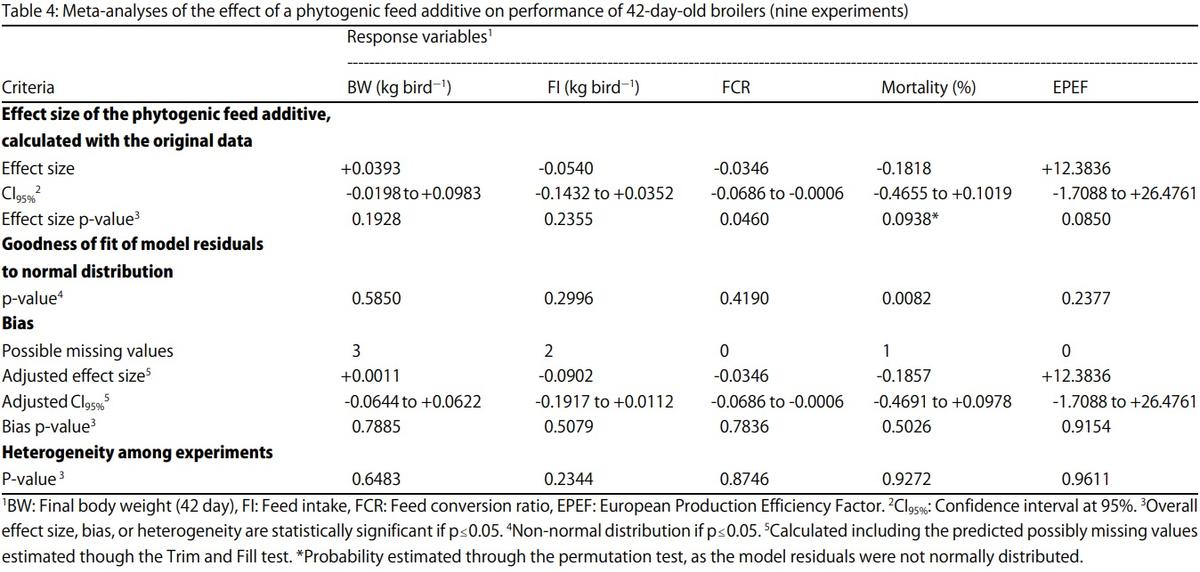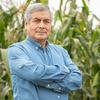Meta-Analysis of Commercial-Scale Trials as a Means to Improve Decision-Making Processes in the Poultry Industry: A Phytogenic Feed Additive Case Study




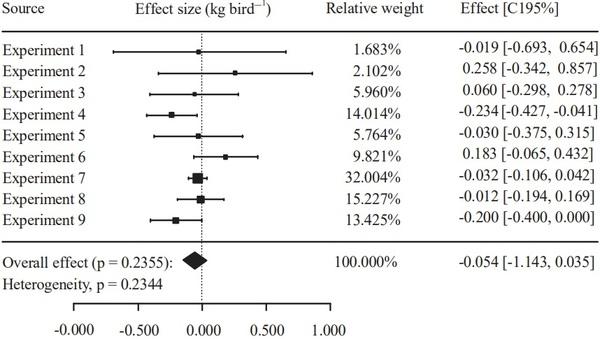
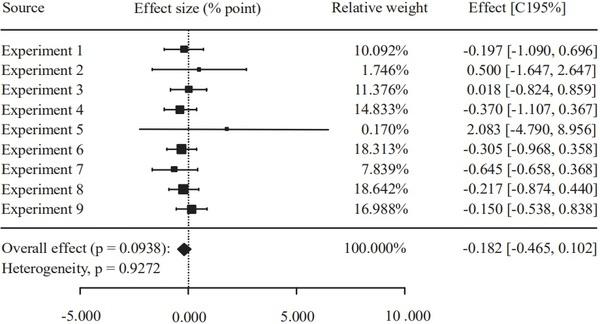
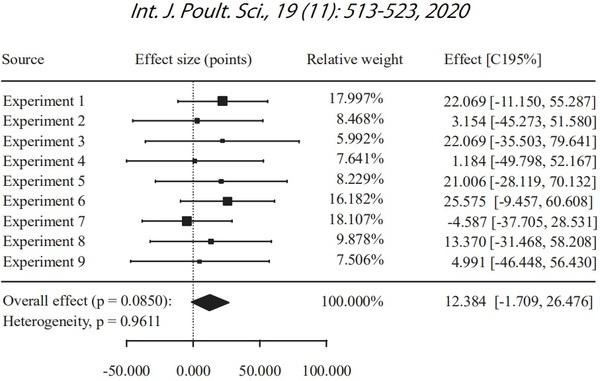

1. Aviagen, 2011. Optimizing Broiler Feed Conversion Ratio.
Arbor Acres service bulletin 0711-AVNAA-029
2. Willems, O.W., S.P. Miller and B.J. Wood, 2013. Aspects of selection for feed efficiency in meat producing poultry.
World's Poult. Sci. J., 69: 77-88.
3. Maharjan, P., J. Weil, A. Beitia, N. Suesuttajit and K. Hilton et al., 2020. In vivo collagen and mixed muscle protein turnover in 2 meat-type broiler strains in relation to woody breast myopathy. Poult. Sci., 10.1016/j.psj.2020.06.059
4. Maharjan, P., G. Mullenix, K. Hilton, A. Beitia and J. Weil et al.,
2020. Effects of dietary amino acid levels and ambient temperature on mixed muscle protein turnover in Pectoralis major during finisher feeding period in two broiler lines. J.
Anim. Physiol. Anim. Nutr., 10.1111/jpn.13363
5. Rostagno, H., L. Páez and L. Albino, 2007. Nutrient
Requirements of Broilers for Optimum Growth and Lean
Mass. Proceeding of 16th European Nutrition Symposium on
Poultry Nutrition. August 26-30, 2007 91-98.
6. Zhang, B., J. Weil, A.B. Guerra, P. Maharjan and K. Hilton et al.,
2020. Egg shell quality and bone status as affected by environmental temperature, ca and non-phytate p intake and
In vitro limestone solubility in single-comb white leghorn hens. Int. J. Poult. Sci., 19: 219-231.
7. IRTA, 2015. Review of immune stimulator substances/agents that are susceptible of being used as feed additives: mode of action and identification of end-points for efficacy assessment. EFSA supporting publication, Catalonia, Spain
Pages: 266.
8. Russo, M., G.C. Galletti, P. Bocchini and A. Carnacini, 1998.
Essential oil chemical composition of wild populations of
Italian oregano spice (Origanum vulgare ssp. hirtum (Link)
Ietswaart): A preliminary evaluation of their use in chemotaxonomy by cluster analysis. 1. inflorescences. J. Agric.
Food Chem., 46: 3741-3746.
9. Helander, I.M., H.L. Alakomi, K. Latva-Kala, T. MattilaSandholm and I. Pol et al., 1998. Characterization of the action of selected essential oil components on gram-negative bacteria. J. Agric. Food Chem., 46: 3590-3595.
10. Lee, K.W., H. Everts and A.C. Beynen, 2004. Essential oils in broiler nutrition. Int. J. Poult. Sci., 3: 738-752.
11. Deighton, N., S.M. Glidewell, S.G. Deans and B.A. Goodman,
1993. Identification by epr spectroscopy of carvacrol and thymol as the major sources of free radicals in the oxidation of plant essential oils. J. Sci. Food Agric., 63: 221-225.
12. Mathe, A., 2009. Essential Oils: Biochemistry, Production and
Utilisation. In: Phytogenics in Animal Nutrition: Natural
Concepts to Optimize Gut Health and Performance, Steiner,
T. (Ed.). Nottingham University Press, England, ISBN:
9781904761716.
13. Applegate, T.J., V. Klose, T. Steiner, A. Ganner and
G. Schatzmayr, 2010. Probiotics and phytogenics for poultry:
Myth or reality? J. Applied Poult. Res., 19: 194-210.
14. Malayoglu, H.B., S. Baysal, Z. Misirlioglu, M. Polat, H. Yilmaz and N. Turan, 2010. Effects of oregano essential oil with or without feed enzymes on growth performance, digestive enzyme, nutrient digestibility, lipid metabolism and immune response of broilers fed on wheat-soybean meal diets. Br. Poult. Sci., 51: 67-80.
15. Dorman, H.J.D. and S.G. Deans, 2000. Antimicrobial agents from plants: Antibacterial activity of plant volatile oils. J.
Applied Microbiol., 88: 308-316.
16. Levkut, M., A. Marcin, V. Revajova, L. Lenhardt and
I. Danielovic et al., 2011. Influence of oregano extract on the intestine, some plasma parameters and growth performance in chickens. Acta Vet. Beograd., 61: 215-225.
17. Giannenas, I., P. Florou-Paneri, M. Papazahariadou,
E. Christaki, N.A. Botsoglou and A.B. Spais, 2003. Effect of dietary supplementation with oregano essential oil on performance of broilers after experimental infection with
Eimeria tenella. Arch. Anim. Nutr., 57: 99-106.
18. Mohiti-Asli, M. and R.M. Ghanaatparast, 2015. Dietary oregano essential oil alleviates experimentally induced coccidiosis in broilers. Preventive Vet. Med., 120: 195-202.
19. Fukayama, E.H., A.G. Bertechini, A. Geraldo, R.K. Kato and
L.D.S. Murgas, 2005. Extrato de orégano como aditivo em rações para frangos de corte. Rev. Bras. Zootecnia,
34: 2316-2326.
20. Baser, K.H.C., 2002. Aromatic biodiversity among the flowering plant taxa of Turkey. Pure Applied Chem.,
74: 527-545.
21. Murugesan, G.R., N.K. Gabler and M.E. Persia, 2014. Effects of direct-fed microbial supplementation on broiler performance, intestinal nutrient transport and integrity under experimental conditions with increased microbial challenge. Br. Poult. Sci.,
55: 89-97.
22. Shim, M.Y. and G.M. Pesti, 2014. The use of a pen-size optimization workbook for experiment research design using the visual basic for applications in excel for poultry. J. Applied
Poult. Res., 23: 315-322.
23. Demétrio, C.G.B., J.F.M. Menten, R.A. Leandro and C. Brien,
2013. Experimental power considerations̶Justifying replication for animal care and use committees. Poult. Sci.,
92: 2490-2497.
24. Cohn, L.D. and J.B. Betsy, 2003. How meta-analysis increases statistical power. Psychol. Methods, 8: 243-253.
25. Borenstein, M., L.V. Hedges, J.P.T. Higgins and H.R. Rothstein,
2009. Power Analysis for Meta Analysis. In: Introduction to
Meta Analysis. Borenstein, M., L.V. Hedges, J.P.T. Higgins and
H.R. Rothstein (Eds.). John Wiley & Sons, Ltd Hoboken, New
Jersey pp: 257-276.
26. Cobb-Vantress, 2015. Broiler performance and nutrition supplement. July 2015. http://www.cobb-vantress.com/docs/ default-source/cobb-500-guides/Cobb500_Broiler_
Performance_And_Nutrition_Supplement.pdf.
27. Marcu, A., I. Vacaru-Opri , G. Dumitrescu, L.P. Ciochin| and
A. Marcu et al., 2013. The influence of genetics on economic efficiency of broiler chickens growth. Anim. Sci. Biotechnol.,
46: 339-346.
28. Petschenka, G., C. Pick, V. Wagschal and S. Dobler, 2013.
Functional evidence for physiological mechanisms to circumvent neurotoxicity of cardenolides in an adapted and a non-adapted hawk-moth species. Proc. R. Soc. B, Vol. 280
10.1098/rspb.2012.3089
29. Adler, J., 2009. R in a Nutshell: A Desktop Quick Reference.
1st Edn., OʼReilly Media Sebastopol, California .
30. Grubbs, F.E., 1969. Procedures for detecting outlying observations in samples. Technometrics, 11: 1-21.
31. McDonald, J.H., 2009. Handbook of Biological Statistics.
2nd Edn., Sparky House Publishing, Baltimore, Maryland.
32. Noortgate, V.d., W. Onghena and Patrick, 2003. Multilevel meta-analysis: A comparison with traditional meta-analytical procedures. Educ. Psychol. Meas., 63: 765-790.
33. Hedges, L.V. and I. Olkin, 1985. Parametric Estimation of Effect
Size from a Series of Experiments. In: Statistical Methods for
Meta-Analysis. Hedges, L.V. and I. Olkin, Academic Press Inc.,
United States of America pp: 107-145.
34. Bougouin, A., J.A.D.R.N. Appuhamy, E. Kebreab, J. Dijkstra,
R.P. Kwakkel and J. France, 2014. Effects of phytase supplementation on phosphorus retention in broilers and layers: A meta-analysis. Poult. Sci., 93: 1981-1992.
35. Motulsky, H.J., 2007. Graphpad prism 5.00 Statistics Guide.
GraphPad Software, inc. https://cdn.graphpad.com/faq/2/file/
Prism_v5_Statistics_Guide.pdf
36. SAS, 2017. Base SAS®
9.4 procedures guide. 7th Edn., SAS
Institute, Inc., North Carolina, USA Pages: 175.
37. Viechtbauer, W., 2010. Conducting meta-analyses in R with the metafor package. J. Stat. Software, Vol. 36, No. 3
10.18637/jss.v036.i03
38. R Core Team., 2018. R: A language and environment for statistical computing. R Foundation for Statistical Computing,
Vienna, Austria.
39. RStudio, 2016. RStudio: integrated development for R.
RStudio Inc.,. https://rstudio.com
40. Dawkins, M.S., 2012. Commercial scale research and assessment of poultry welfare. Br. Poult. Sci., 53: 1-6.
41. Hirshleifer, D., Y. Levi, B. Lourie and S.H. Teoha, 2019. Decision fatigue and heuristic analyst forecasts. J. Financial Econ.,
133: 83-98.
42. Nicholls, N., 2001. The Insignificance of Significance Testing.
Bull. Amer. Meteor. Soc., 82: 981-986.
43. Blackwelder, W.C., 1982. “Proving the null hypothesis” in clinical trials. Controlled Clin. Trials, 3: 345-353.
44. Dragicevic, P., 2016. Fair Statistical Communication in HCI.
In: Modern Statistical Methods for HCI. Robertson, J. and
M. Kaptein (Eds.). Springer, Cham Switzerland pp: 291-330.
45. Chris, O. and W.H. Freeman, 2002. The Lady Tasting Tea: How
Statistics Revolutionized Science in the Twentieth Century.
American Statistical Association United States of America
Pages: 650.
46. Roofchaee, A., M. Irani, M.A. Ebrahimzadeh and M.R. Akbari,
2011. Effect of dietary oregano (Origanum vulgare L.) essential oil on growth performance, cecal microflora and serum antioxidant activity of broiler chickens. Afr. J.
Biotechnol., 10: 6177-6183.
47. Cho, J.H., H.J. Kim and I.H. Kim, 2014. Effects of phytogenic feed additive on growth performance, digestibility, blood metabolites, intestinal microbiota, meat color and relative organ weight after oral challenge with Clostridium perfringens in broilers. Livest. Sci., 160: 82-88.
48. Ghazi, S., T. Amjadian and S. Norouzi, 2014. Single and combined effects of vitamin C and oregano essential oil in diet, on growth performance and blood parameters of broiler chicks reared under heat stress condition. Int. J. Biometeorol.,
58: 741-752.
49. Peng, Q.Y., J.D. Li, Z. Li, Z.Y. Duan and Y.P. Wu, 2016. Effects of dietary supplementation with oregano essential oil on growth performance, carcass traits and jejunal morphology in broiler chickens. Anim. Feed Sci. Technol., 214: 148-153.
50. Martinez, D.A., 2012. Evaluación de un producto a base de aceite esencial de orégano sobre la integridad intestinal, la capacidad de absorción de nutrientes y el comportamiento productivo de pollos de carne. Master Thesis, Universidad
Nacional Agraria La Molina.
51. Bregendahl, K., D.U. Ahn, D.W. Trampel and J.M. Campbell,
2005. Effects of dietary spray-dried bovine plasma protein on broiler growth performance and breast-meat yield. J. Applied
Poult. Res., 14: 560-568.
52. Barker, K.J., J.L. Purswell, J.D. Davis, H.M. Parker, M.T. Kidd,
C.D. McDaniel and A.S. Kiess, 2010. Distribution of bacteria at different poultry litter depths1
. Int. J. Poult. Sci., 9: 10-13.
53. OʼReilly, E.L., R.J. Burchmore, N.H. Sparks and P.D. Eckersall,
2016. The effect of microbial challenge on the intestinal proteome of broiler chickens. Proteome Sci., Vol. 15, No. 10
10.1186/s12953-017-0118-0
54. Gaibor, J.R.Q., R. Torres, J. Yupanqui, D.M. Patiño-Patroni and
C.V. Perales, 2019. Suplementación alimenticia de glutamina sobre el desempeño productivo en pollos de engorde.
Siembra, 6: 15-24.
55. Campbell, M.K. and D.J. Torgerson, 1999. Bootstrapping:
Estimating confidence intervals for cost-effectiveness ratios.
Int. J. Med., 92: 177-182.
56. Martínez, D. and C. Uculmana, 2016. Extracto de alcachofa (Cynara scolymus L.): experiencias de uso en los mercados de producción animal y oportunidades para su producción en
Perú [Artichoke extract (Cynara scolymus L.): experiences of use in animal production markets and opportunities for its production in Peru]. Agroind. Sci., 6: 155-161.
57. Hooge, D.M., J.L. Pierce, K.W. McBride and P.J. Rigolin, 2010.
Meta-analysis of laying hen trials using diets with or without allzyme®
SSF enzyme complex. Int. J. Poult. Sci., 9: 824-827.
58. Quisirumbay-Gaibor, J., D.M. Patiño-Patroni and
C.V. Perales, 2020. Efecto de la suplementación de selenio sobre el rendimientoproductivo en cerdos: metaanálisis
[Effect of selenium supplementation on productive performance in pigs:meta-analysis]. Rev. Inv. Vet. Perú,
Vol. 31, No. 1.
59. Richter, S.H., J.P. Garner, C. Auer, J. Kunert and H. Wurbel,
2010. Systematic variation improves reproducibility of animal experiments. Nat. Methods, 7: 167-168.




